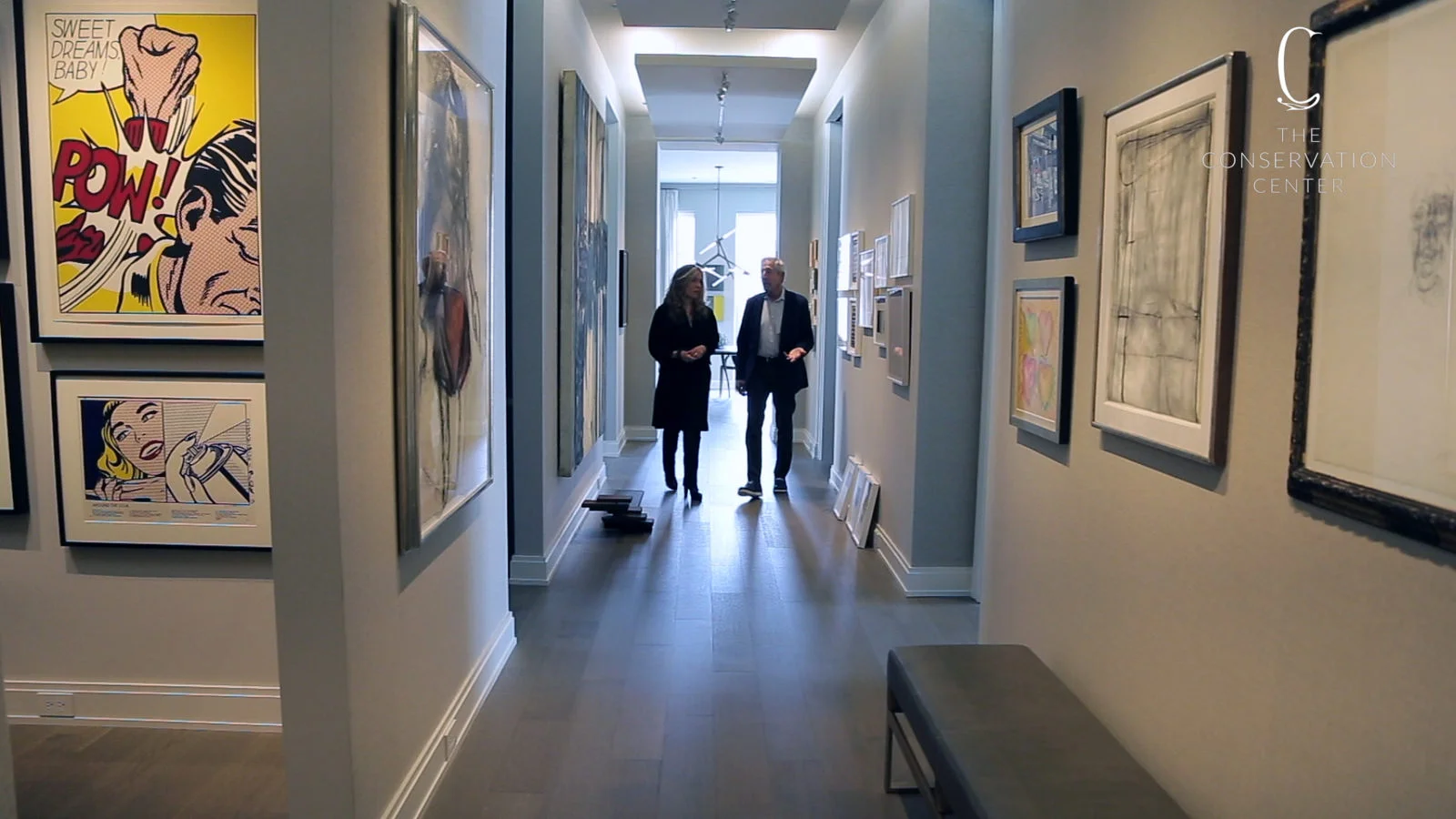Currently, the painting is undergoing surface cleaning to remove grime and accretions that have built up on the piece over time, with the right half having been cleaned, and the left half still awaiting treatment. The reverse of the painting will also be cleaned, using a soft brush and vacuum. To complete treatment, conservators will continue to locally consolidate areas of flaking paint, and to fill and texture losses in the painted surface. Inpainting will also be carried out in areas of loss and abrasion, using reversible conservation paints.
Richard Tuttle: A Collaborative Repair
Adhering to the Visual Artists Rights Act of 1990, The Center collaborated with Richard Tuttle to determine the best treatment methods for the works, Blue/Red (white) and Blue/Red (x-bullet). After transporting the pieces to New York for the artist to review and approve the proposed treatment, Tuttle decided that surface cleaning was not necessary.
Conserving the Canon: A Biblical Scene Revealed
The process of conservation can often yield dramatic results, revealing images that have been hidden behind dust and grime or aging varnish for years. This is certainly the case with a painting that we recently treated here at The Center. When the piece first arrived, it was not completely clear exactly what the painted image portrayed. Though the painting depicts the well-known Biblical scene of the Visitation, showing Mary greeting her cousin Elizabeth, as Joseph shakes hands with Zachariah, the image had been obscured by age-related issues.
To learn more about the conservation of the piece and the dramatic results, we sat down to discuss the process in greater detail with our Senior Paintings Conservator, Amber Schabdach. Read our interview with Amber here, and watch the video at the bottom of the interview to see the conservation process from start to finish.
To Preserve and Protect: The Framing of an Edward Curtis Photogravure
Earlier this year, we had the privilege of framing an Edward Curtis photogravure, Two Strike. Little did we know, the piece would end up being featured in the Muskegon Museum of Art’s exhibition Edward S. Curtis: The North American Indian. Described as “an event of national significance celebrating the artistic genius and lasting cultural legacy of Edward Curtis,” the exhibition covers the work of a man “who sacrificed everything for is art, died in obscurity, but left behind one of the greatest artistic collaborations and photographed achievements in history.”
Maneuvering Through Moving Damage: One Client's Journey
It was the middle of a hot July, and Tom Reiss was in the process of moving across the state of Michigan to resettle his home closer to the lake. When the hired moving company unloaded his collection of fine antique furniture and heirlooms from their truck, Tom was astonished by the way his pieces were packed and the manner in which they were being handled and unloaded.
Conservation Conversations: Steve Ryan, Senior Furniture Conservator
Click here to watch the interview with our Senior Furniture Conservator.
Inside Disaster Response: How Did The Experts Become Experts?
For over twenty five years, The Center has been at the forefront of the disaster response field and in that time we've seen disasters from house fires and floods to hurricanes and tornadoes. It is a difficult field, as situations often prove to be mentally, emotionally, and physically trying. We rely on a team of veteran responders to train new staff members on procedures, prevention, and protection. In this article we will follow the journey of Client Services Associate, Sarah Phalen, and her intoroduction to disaster response.
The Center's New Space: State-Of-The-Art Storage For Art Of All Kinds
We are pleased to announce the acquisition of two additional storage facilities, located just blocks from our 400 N. Wolcott main location. With the addition of these spaces, we have also expanded our shipping and art handling team to allow us to not only offer more state-of-the-art secure storage, but also to continue to expand our dedicated and professional team to meet the growing demand of our clients’ public, private, and commercial collections.
Serving and Conserving: The Story of a Civil War Sword
At The Conservation Center, we are tremendously lucky to act as stewards of history. Representations of the past come to our facility each day in the form of photographs, paintings, drawings, documents, and objects, and collectively, we spend hours studying, interacting with, and conserving each of these pieces. Through conservation projects, we learn more about personal histories, family histories, and international history, and each project presents us with the opportunity to help preserve these histories for generations to come. So, when a client came to us with an important family heirloom, that was also a physical remnant of a formative time in the history of our country, we were honored to assist.
Inside Disaster Response: Lessons Learned & Stories Shared
Linear Harmony: Exploring and Preserving the Collection of Buzz Ruttenberg
Buzz Ruttenberg, a passionate collector and an active member of The Conservation Center’s Advisory Board, recently invited our CEO Heather Becker into his home for a conversation and a tour.
Piecing Together a Puzzled Painting
The staff at The Center could not have been more thrilled when a former employee, Megan, brought in a James Jeffrey Grant painting for conservation. It was a lovely, serene landscape painting of cows grazing in a luscious green field. Before finding its current home, the painting hung above a fireplace in Megan’s relative’s home for over 30 years where it was exposed to extreme fluctuations in temperature. Due to this environment, the paint layer was severely compromised and exhibited significant areas of flaking paint overall. This lead to numerous areas of exposed canvas and hundreds of tiny puzzle-like paint pieces that were no longer adhered to the painting’s surface.
Remembering Bob Glick
Dear Friends of The Center:
I am familiar with sharing stories about the life of an object of art but not about the life of a person. It is with great sadness that I share with you that Bob Glick, one of the long standing and dedicated contributors to The Center’s Advisory Board team, recently passed away on April 15, 2017.
"Adding 'Magnetism' to Places Where People Gather": Conserving a 20th Century Television Cabinet with Water Damage
The RCA 648PTK television cabinet was announced on August 27, 1947. With 992 units produced in 1947 and 2,500 units in produced in 1948, the television set was a marvel of technology for its time, boasting a 15” x 20” picture, 13 channel coverage, an FM sound system, and Phono input. Marketed as a “striking ‘show-piece,’” the technology was all housed in a sleek, contemporary wooden cabinet, that would “add pride to ownership” for anyone who purchased the piece.
At The Conservation Center, we are always excited to treat pieces that utilize a wide range of our conservators’ skills, and help to preserve important moments in our cultural history. So, when a RCA 648PTK television cabinet came to us from the Children’s Museum of Indianapolis with water damage, we were excited to discuss the treatment options available for the conservation of the piece.
Our Favorite Artists: Selecting A Frame For Mucha's "La Dame"
At The Conservation Center we are very fortunate to be surrounded by amazing art everyday. It is an extraordinary opportunity to work so intimately with many great pieces created by artists you have studied your whole life. However during the day-to-day we often find ourselves focusing more on the physicality of the pieces as opposed to having discussions about the many artists that sparked our interest in this field in the first place. Read on to the end of this article to find out which artists are some of our team's favorites! Recently, we had the opportunity to conserve and frame one of our regular favorites, Alphonse Mucha.
History Retouched: Preserving A Handmade Scrapbook
After years of storage in a basement and, later, a garage, an old photo album our client acquired had fallen into disrepair. “The pictures were in disarray and I was devastated. I was just so sorry I didn’t take the proper care,” our client shared. The photographs of her mother, father, and young brother were taken in Virginia between 1935 and 1942. While in storage, they had become discolored and distorted from age and exposure to moisture and temperature fluctuations. Motivated by a desire to restore the photographs and share them with her family, Shirley brought the album to The Conservation Center.
Laissez Les Bons Temps Rouler! The Conservation of Two Lithographs from New Orleans
The Conservation Center recently had the privilege of conserving two lithographs that were damaged by Hurricane Katrina. Our client inherited A Midnight Race on the Mississippi by Currier & Ives and J.J. Audubon’s Purple Martin (Calabash) from their parents in New Orleans. The pieces had been living in a second-floor storage unit when Hurricane Katrina blew through and ripped the roof off the facility, causing water to seep into the unit.
Frame By Frame: Chagall Installation
The Center recently had the remarkable opportunity to work on a large tapestry created by Marc Chagall. The piece, which is one of only three works by the artist in Chicago, remained unfinished at the time of the Chagall's death. Created and commissioned with the intention to uplift and inspire, the work features a unique and vibrant blue that, for the artist, symbolized hope.
Click here to watch the video.
To Collect and Conserve: A Behind-The-Scenes Look Into Norm Bobins' Collection
At The Conservation Center, we have the distinct privilege of seeing a remarkable variety of artworks and heirlooms come through our doors. We also have the privilege of getting to learn a bit about varied passions of the many dedicated collectors that seek conservation, and what it is that makes each of their collections unique.
To watch the video, click here.
Conserving the Condemned: The Last Judgement
There are certain iconic scenes in art that everyone from the casual museum-goer to the serious art collector can recognize instantly. Scenes including the Last Supper, the rising of Apollo’s chariot, and the triumph of David over Goliath have been depicted by artists across the span of art history, and though the style and medium of these artworks may vary, the scenes remain easily identifiable. Another of these iconic scenes is that of the Last Judgement. Artworks imagining the moment when the fate of souls is determined for eternity can be seen everywhere from the Sistine Chapel to local church walls. So when a large-scale painting of the signature scene came to The Conservation Center in need of treatment, we were honored to play a role in its conservation and preservation.





















